Wild India: Keoladeo Ghana National Park – No more Ghana
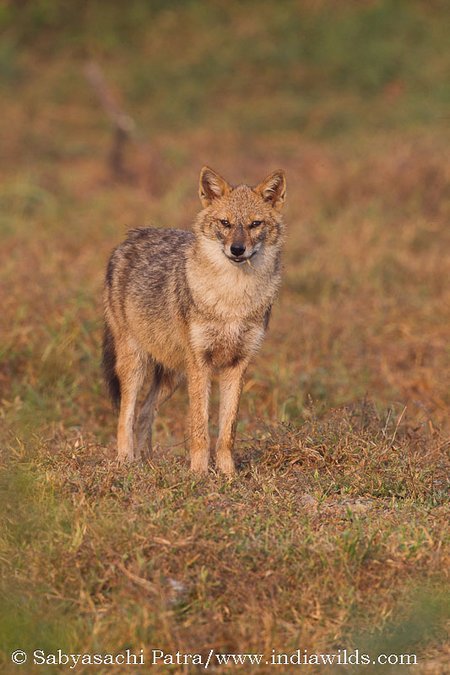
A jackal with leaf in the mouth in Keoladeo Ghana
Keoladeo Ghana National Park is perhaps one place in Wild India which was created by man for the shooting pleasure of the Maharaja. So the title Wild India: Keoladeo Ghana National Park was to put it in context of a man made place becoming a major wildlife attraction. I have been visiting Keoladeo Ghana bird sanctuary in bharatpur every year. The only years I missed visiting bharatpur are the years when the park faced water scarcity. Keoladeo Ghana is a man made wetland. The ruler of bharatpur had prepared dykes and had brought in water from the canal to create a bird hunting ground for himself and his guests. Spread over an area of 27 sq km, the wetland portion is about 10 hectares. When one looks at these facts, one gets the confidence that with a little bit of thought and planning, we can create enabling conditions for nature to take over.
When one hears that there were leopards in this park, one should not be amazed as there are spotted deers, sambar, nilgai, wild boar, jackals, hyenas, fishing cats, jungle cats, pythons etc in the park. A few years back a tigress had come to the park and had lived there for a few years till she died of old age. Recently, a male tiger has come from Ranthambhore and have taken its residence here. It is a mystery as to how it survived in the open fields, as there is very less of forest cover in between.
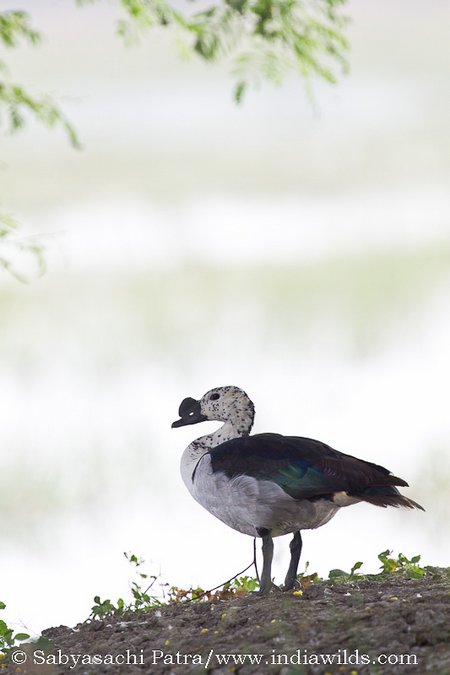
Sarkidiornis melanotos or Comb duck in Keoladeo Ghana
I reached the hotel and immediately started for the park, thought the light at noon is not conducive for photography. However, I wanted to get a feel of the jungle and hoped to sight a few carnivores. I took one rickshaw however, the driver was not good in bird identification. Ofcourse, his job became easier, as there were hardly any birds in the park.
All along, I had been told that there is lot of water in the park, however, when I entered into the park, I realised that it was propaganda by the hotel lobby. There were hardly any migratory species in the park in significant numbers.
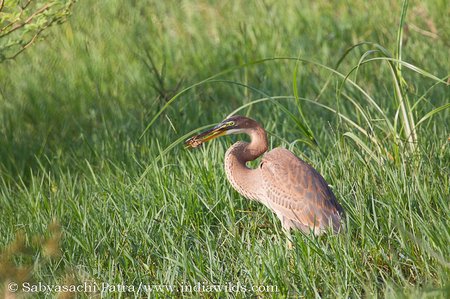
Predator and Prey: A Purple Heron with catch in Keoladeo Ghana
On the main road to my left, I could see only 7 painted storks nesting on their regular nesting site. The rickshaw puller said that is all as far as painted storks arrival to this park is concerned. Later I saw about 10 painted storks in the same spot. There were a couple of open billed storks, 3-4 grey herons and a few purple herons. I saw a group of lesser whistling teals (about 20), cormorants about 20-30. There may be more in other parts of the park. Parakeets, Grey Francolins, a couple of kingfishers, one lesser spotted eagle, asian koel, one Indian moorehen near the entry of the park ie. about half a kilometer away from water, and a few peafowls, bulbuls, shrike etc. I saw only one male comb duck (Sarkidiornis melanotos).
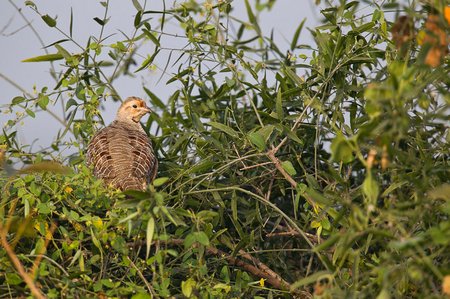
Grey Francolin on tree in Keoladeo Ghana National Park bharatpur
In short, the number of birds and the number of species present in bharatpur as on Oct 2010, doesn’t merit a visit there. You will find more birds in your local swamp/wetland, than in bharatpur.
Other changes in Keoladeo Ghana National Park:
The visitor entry fees has been doubled from Rs. 25 to Rs. 50. Rickshaw charges have been increased from Rs. 50 per hour to Rs. 70 per hour. Rickshaw pullers have been given id cards and they need to swipe it infront of a card reader before entering into the park (second gate near the boating area). That will help in keeping a tab on the entry and exit times.
I saw a number of roads closed to public. I was told that those roads are closed so as to prevent people from reaching the area where the tiger movement is more. Though the general public is not allowed to get in, I saw the forest department gypsy carrying presumably family members into the park after the gates closed at 6 pm and also I saw the same people returning at 6.50 am in the morning. One can easily guess, that they were on a tiger safari after and before park timings into the areas where general public is not allowed.
Infact, my rickshaw puller was banned for 7 days as he was 2 mins late. And this happened right after the official gypsy carrying the “tourists” /relatives into the park (on 22nd Oct).
There are local people inside the park collecting wood, cutting grass etc. The number of cattle grazing has increased. Earlier, one used to find the feral cattle. Now the regular milch cows are also sent to the park for grazing. So the Park authorities appear to be more intent on controlling the rickshaw pullers and tourists and turning a blind eye on the disturbances and rule violations caused by the locals.
In 2008, the Park authorities had entrusted the local villagers in uprooting the prospis juliflora plants. Areas were demarcated for each family to uproot and take the plants. I was told that each family made upto one lakh rupees. The forest department did this hoping that they will earn the goodwill of the local residents.
Though the prosopis juliflora is an invasive species, uprooting those gave rise to open areas. With increased number of cattle grazing in the park, and collection of fallen branches and wood cutting, the park is no longer dense with vegetation any more. Keoladeo Ghana National Park has got its name Ghana due to the dense vegetation in the park. These days, it would be apt to drop the name Ghana from the Keoladeo Ghana National Park.
The temperature was much higher than that in Delhi. One needs to switch on the Air conditioner in the hotels. Given the high temperature in bharatpur, the water is drying up fast. Migratory birds like ducks and geese etc may give the park a skip this year, if the water doesn’t remain. I am not sure whether the water level will dry up before January or not. Definitely, February will have no water, if there are no rains. In all probability, the migratory birds appear to be skipping the park this year. With the continued neglect by the authorities and the local people in supplying water from the dam, Keoladeo Ghana may soon be a lost cause forever.
Other Facts:
Season: Open throughout the year. Winter is good for migratory birds.
How to Reach Bharatpur:
In case, you are still interested in visiting Keoladeo National Park in bharatpur.
By train: Easiest to approach by train from Delhi. You can take the Golden Temple, Kota Janashatabdi or other trains as per your convenience. The Bharatpur (code BTE) station is about 2kms and 25mins away from the Park.
By Road: Distance is about 179 kms from Delhi and 56kms from Agra. If you are driving from Delhi then take the NH2 to Mathura via Faridabad, Palwal, Hodal and from Mathura to Bharatpur by the state road.
Accomodation: There are many hotels near the Park and one should be ready to search for the hotel that suits the budget.
If you have any questions about Wild India: Keoladeo Ghana National Park then ask in the comments section below.
- Endangered Wild Buffalo of Kaziranga - 4 July,2024
- Leopards: The Last Stand Trailer 2 - 1 July,2024
- GoPro Hero 12 Black - 6 September,2023


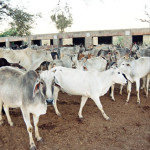
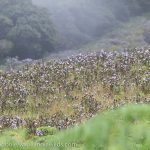

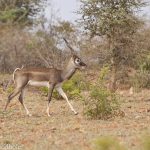
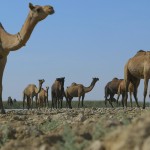
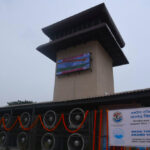




The Keoladeo Ghana National Park is a UNESCO World Heritage Site. The best time for bird watching is either during sunrise or during sunset. Boating facilities are available at the lake and one can really go up close to the birds and watch them frolicking with gay abandon.